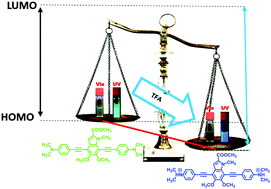Effects of structural variations on the optical and electronic properties of eumelanin-inspired small molecules†
Abstract
In this work, five new eumelanin-inspired indole small molecules have been synthesized which differ by the substituents attached to the para position of the phenylene ring. The effects of structural variations on the optoelectronic properties of these molecules have been studied by combining both synthetic and computational techniques. It has been found that Density Functional Theory (DFT) is well suited to predict energy values for HOMOs, with a maximum difference between the experiment and the theoretical error of 6.2% while time-dependent density functional theory (TD-DFT) predictions for LUMO energies differ at most by 5.2%. The results suggest that the frontier orbitals, and hence the bandgap of the molecules can be manipulated by substituting different electron donating and electron withdrawing groups at the para position of the phenylene ring. DFT can be useful in the prediction of the eigenvalues of molecular orbitals of eumelanin-inspired conjugated molecules. Furthermore, the effect of protonation on the dimethylamino functionalized small molecule showed potential applications as an acidochromic sensor.

- This article is part of the themed collection: Emerging Investigators 2016: Novel design strategies for new functional materials

 Please wait while we load your content...
Please wait while we load your content...